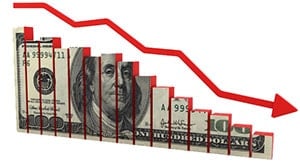-- Published: Monday, 21 May 2018 | Print | Disqus
By Clint Siegner
Practically nobody enters the foreign exchange markets looking to buy and hold. Currency trading is generally a short-term game, and there isn’t much regard for analysis of the longer-term fundamentals.
That much is evident given the ongoing rally in the Federal Reserve Note dollar, despite its outlook being downright grim.

Nobody should be fooled by recent outperformance relative to the currencies of other insolvent nations.
The greenback is in the worst shape of its life.
Sound money advocates are already well versed as to why the dollar has been losing purchasing power ever since the Federal Reserve took control of its fortunes more than a century ago. They understand the implications of perpetually rising federal deficits and debt.
The most recent decade, during which federal borrowing has begun growing exponentially, indicates we are much closer to the end of the cycle – insolvency and default – than we are to the beginning. But it isn’t the only indication that we are approaching the end-game.
The Federal Reserve Note’s hegemony in the global oil trade is starting to fall apart. Russia, China, and other BRIC nations are cutting deals to buy and sell oil using other currencies.
We can now add the EU to the list of potential defectors.

European officials who do not support American withdrawal from the nuclear deal with Iran, or the renewed sanctions, are considering buying Iranian oil with euros. It will be a very big deal if Europeans follow through and make large scale oil purchases using anything other than the dollar.
Reuters reports the decision to resume sanctions on Iran has led to a spike in trading activity of Chinese crude oil futures, which are denominated in yuan. Trading began in this market last year and volume has been growing steadily. When sanctions were announced, the volume doubled overnight to a record 250,000 contracts, which represented 12% of the global trade in crude.
If the Chinese oil trade continues at the rate of growth it has had over the past year, the world is only a few years away from the "petro-yuan" taking the place of the "petro-dollar."
President Trump’s initiative to support domestic manufacturers by imposing tariffs on imported products may also have dire consequences for the Federal Reserve Note in global foreign exchange markets.
The U.S. has been exporting its currency to trading partners eager to exchange for goods and services. If demand for the dollar diminishes overseas, it isn’t hard to predict what will happen to the dollar’s exchange value.
Nobody can say for sure where the Federal Reserve Note’s trading value against other major currencies is headed in the next weeks and months. Perhaps the rally will continue.
Investors can predict with near certainty, however, that our currency will buy less of everything – including oil, manufactured goods, and gold – in the coming years. That trend is more certain than ever.
Clint Siegner is a Director at Money Metals Exchange, the national precious metals company named 2015 "Dealer of the Year" in the United States by an independent global ratings group. A graduate of Linfield College in Oregon, Siegner puts his experience in business management along with his passion for personal liberty, limited government, and honest money into the development of Money Metals' brand and reach. This includes writing extensively on the bullion markets and their intersection with policy and world affairs.
| Digg This Article
-- Published: Monday, 21 May 2018 | E-Mail | Print | Source: GoldSeek.com

